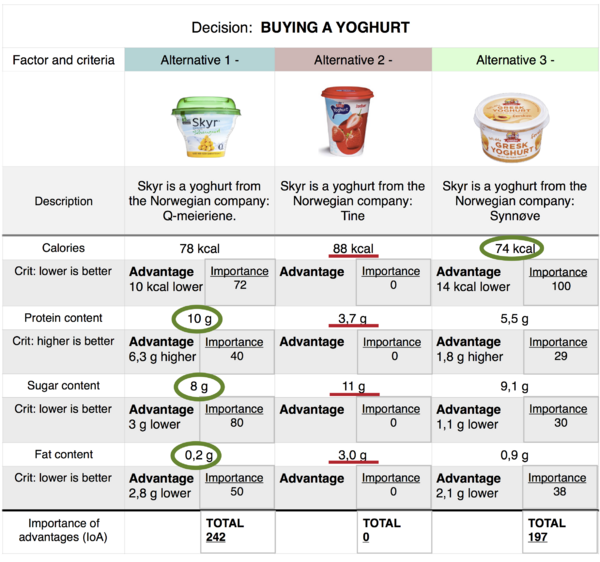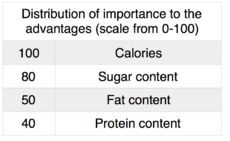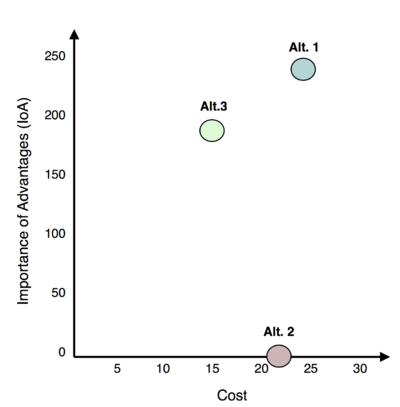Choosing by Advantages (CBA)
Developed by Marianne Delp
Decision-making processes are important due to its significant impacts on the actual outcome. Sound decision-making skills are especially important for people who make decisions that affects other people. This includes for example architects, engineers, governments, psychologists, educators, consultants and leaders. Decisions can be affected by experiences, arguments, positions, biases and time restrictions that all can lead to unintended results. Using a sound decision process is essential to achieving sound results.
Choosing by Advantages (CBA) is a decision-making system that include a wide variety of decision-making methods, definitions, principles and models. The purpose of the CBA system is to make it a sound process and simplify decision-making. CBA hinders double-counting through focusing on decisions based on the importance of advantages (IoA), not advantages and disadvantages [1]. The CBA system supports visual and transparent decision-making with an collaborate and integrating environment that acknowledges that decisions are essentially subjective. Values and culture of Lean/IPD project management are aligned with an emphasis on project's value for stakeholders and the use of data [2].
Virtually, the CBA system can be applied in all decision-making processes, simple and more complex situations [3] [4]. However, the CBA system demands use of more resources in comparison with for example experienced based decisions. CBA is often used when in need for sound methods due to the importance of the decisions. This does not directly relate to the size or scope of the decision. The CBA can be implemented in project-program and portfolio management depending on the decision and who is responsible for the decision-making [5] [6] [7].
The principles in the CBA system are explained by the definitions and models, where the methods applies the principles. The CBA system is based on four central principles [1]:
1. The foundation principle of sound decision-making
2. The fundamental rule of sound decision-making
3. The principle of anchoring
4. The pivotal sound–decision-making
This article will look into the CBA concept, purpose, current state, limitations and a made-up example using the Tabular Method of CBA to describe how to applicate a CBA as a decision-making system.
Contents |
Big idea
Decision-making methods can influence people's decisions that further trigger actions, thus lead the actions to cause outcomes. The outcomes of decisions can be of great importance and with a high degree of complexity. For example in the architecture, engineering and construction industry there is a need for decisions to be supported by decision-making processes. The CBA is in comparison with the traditional engineering projects re-engineering the art system of decision-making [3].
Concept and purpose
Choosing by Advantages (CBA) is a decision-making process that offers methods that support creation of transparency and collaborative environments in which to make decisions. This method for making decisions are made when several goals or criteria has to be evaluated at once: design choices and concept choices. In addition to the decision methods, CBA includes definitions, principles and models. Figure 1 presents CBA definitions adapted from Suhr [8].
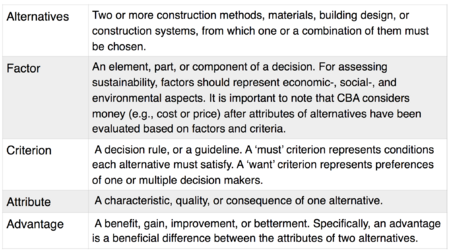
The principles in the CBA system are explained by the definitions and models, where the methods applies the principles. The CBA system is based on four central principles :
1. The foundation principle of sound decision-making - decision makers must learn and skillfully use sound methods of decision-making
2. The fundamental rule of sound decision-making - decisions must be based on the importance of advantages
3. The principle of anchoring - decisions must be anchored to the relevant facts
4. The pivotal sound–decision-making - different types of decisions call for different sound methods of decision-making
The CBA decisions are based on the importance of advantages (Principle 2), not disadvantages and advantages. This ensures the process to have no double-counting.
The purpose of the CBA system is to support sound decision-making through achieving transparent-and congruent decisions, anchor subjective evaluation in facts and emphasize on actual benefits.
The system is easy to applicate and simplifies complex decision-making through differentiate alternatives and understand the importance of those. It is important to mention that the CBA system focuses on using the correct data and use the data correctly, on the basis that the decisions must be anchored to the relevant facts. The CBA system are aligned with the values and culture of Lean/["IPD"] project management with an emphasis on project's value for stakeholders and the use of data.
Current state
Today's decision-making processes needs to be emphasized in a way where architects, engineers, leaders in organizations, and many others should become artist in the art of decision-making. The designer of the CBA system, Jim Suhr, state that they should become professional decision-makers since decisions is what they do for a living [3].
Furthermore, Suhr describes the CBA as a process for making sound decisions for both simple and complex decisions [3]. However, the CBA system demands use of more resources in comparison with for example experienced based decisions. CBA is often used when in need for sound methods due to the importance of the decisions. This does not directly relate to the size or scope of the decision. The CBA can be implemented in project-program and portfolio management depending on the decision and who are responsible for the decision-making [5] [6] [7].
Examples of application of the CBA system: 1) Program management - an analysis of a Business case that leads to a rejection or approval of the Business Case in relation to the outputs, outcome and benefits of the project. 2) Project management - an analysis of which type of window to order from a supplier for a primary-school project. 3) Portfolio Management - an analysis of which project(s) to invest in that will be beneficial for the company the program manager works in.
Some traditional decision making processes today are based on earlier experiences, arguments, hierarchy based authority and time restrictions that all can lead to unintended results [8]. Other examples that also can hinder a sound process are biases and time restrictions.
Types of ["Biases"] are:
- Confirmation bias: seeking after approval. Example: "I was right"
- Anchoring: focusing on the wrong things - Focusing illusion: focus too much on one thing - Group Polarization Bias: intensifies decisions and choices more critically
- Framing: not focusing/discovered the best alternative. Example: "alternative 1 is cheaper than alternative 2" .
and types of time restrictions can result in the decision process:
["System 1 - Fast Thinking"]: Unconscious, effortless and automatic thinking. Forms stereotypes based on previous experience and creates bias by quick reaction.
It is important to be conscious of the tricks your mind can play to you and rely more on data, look for multiple arguments and in group settings gather individual opinions first, then consolidate. These examples can all cause a non-sound processes with an unintended result.
Today there is a global trend that focuses on sustainable projects. This will have more stakeholder involvement by the experiencing globalization together with the rise of multinational companies that have created a demand for increased innovation, renommé/reputation and effective work environment. This demand results in more complex supply chain management [1].
CBA is an effective decision-making system that can be applied in sustainable decision making. It works well in decision of mutually exclusive alternatives, for example structural frame types for a building, and when prioritizing resource allocation such as how to best apply labor resources or which value-add options should be adopted to generate the most savings [2].. Moreover, there exists barriers when applying CBA system that will be further discussed later in the article.
Application example: Choosing a yoghurt
Guidance
This section will provide guidance on how to use and apply the CBA system. Firstly, the "CBA Tabular Method" is reviewed. This method is divided into the following five phases: (1) Stage-setting Phase, (2) Innovation Phase, (3) Decision-making phase, (4) Reconsideration Phase, and (5) Implementation Phase.
The focus in this article is on Decision-making phase (3). This phase is described in the following 7 steps (see Figure 2):
1. Identify alternatives
2. Define factors
3. Define criteria for each factor
4. Describe attributes for each alternative
5. Decide advantages for each attribute
6. Evaluate importance of each advantage
7. Evaluate cost
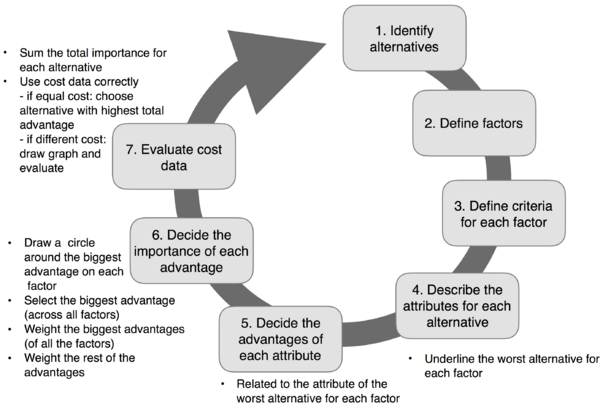
Application
Figure 2 shows the CBA decision-making phase, including needed action in each step. To fully understand the implementation of the CBA processes, an self-made example is given. The decision that need to be taken is which yoghurt to buy based on different alternatives, factors and importance of advantages (IoA). See Figure 3 for CBA Table.
Note! The cost can not be chosen as a factor. The cost is applied and reviewed in a Importance of Advantages (IoA) versus cost graph, that are based on the table output from the following seven steps:
Step 1
Choose the alternatives.
In this case the alternatives are a lemon yoghurt, strawberry yoghurt and a peach yoghurt.
Step 2
Defining the factors with the purpose of differentiating between alternatives.
In the example this is: calories, protein content, sugar content and fat content.
Step 3
Agreement on the criteria for each factor. This criteria is used to evaluate the attribute of alternatives. The criterion can be two types of decision rule: desirable (want) or mandatory (must).
In the example this is written after 'Crit:'. One example is for the 'calories' where the criteria is 'lower is better'.
Step 4
Summarize the attribute of each alternative, and underline the worst attribute.
In the example for the criteria 'calories' this is Alternative 2 with 88 kcal.
Step 5
Decide the advantages of each attribute. This is done by relating the two other alternatives to the least-preferred one / worst alternative.
As mentioned, the worst attribute = Alternative 2 with 88 kcal. In comparison with other alternatives:
- Alternative 1 : advantage = '10 kcal lower' since it contains 78 kcal.
- Alternative 2 : advantage = '14 kcal lower' since it contains 74 kcal.
Then the best attribute for this criteria = Alternative 3.
Step 6
The best attribute for each criteria is marked with a circle.
For the criteria 'calories', the attribute for Alternative 3 is circled.
Then, explicit state preferences of distribution of the advantages of importances (IoA) from a scale from 0-100, see Figure 4 for case example. The least-preferred attribute / worst attribute always gets a 'Importance' of zero, relative to itself.
The other alternative(s) are compared to the most-preferred attribute with the following calculation:
IoA (compared alt.) = Advantage (most-preferred alternative) * Advantage (compared alternative) / IoA (most preferred alternative)
In the example the criteria 'calories' are weighted 100 (i.e. most important criteria).
Alternative 3 is the most-preferred attribute and thereby have importance of 100.
Alternative 1 is the least-preferred attribute / worst attribute and thereby have importance of 0.
Alternative 2 are weighted compared to alternative 1 (most-preferred). The advantage is 10 kcal lower. Then the importance is: 14 kcal/100 * 10 kcal lower = 72
Step 7
Summarize the total IoA for each alternative.
In the example for Alternative 1:
Total IoA = 72 + 40 + 80 + 50 = 242
Then the total IoA for each alternative are compared to cost in an 'Importance of Advantages versus cost graph'.
See Figure 5 for illustration of the example. Here I would have chosen Alternative 1 based on that the advantages of this alternative are much higher than the others and where the cost are not many NOK extra.
This CBA process is a highly collaborative and integrating process of parties, for example stakeholders. Furthermore, the alternative chosen must be reconsidered (Phase 4) in regard to if it exists other alternatives and that the IoA distribution reflects stakeholders viewpoint.
Limitations
As mentioned, the CBA system is helpful in integrating multiple stakeholders perspectives, identification of advantages, transparent and conflict-free trade-offs between alternatives, providing documentation for decision-making rationale and separating "value" of the alternatives from the cost and alternatives (cost vs value).
Thus, it is needed to mention the limitations and barriers of the CBA system. Some examples are [1]:
- Need for intensive time / resource use in data collection and participation.
- The used time can exceed the expectation of the team.
- In sustainable decision making, not all manufactures have an EPD (Environmental Product Declaration) where data collection can be challenging, e.g. comparing products from the environmental perspective.
- Challenging in participation of all stakeholders together F2F (Face-to-Face) in the same room at the moment of the decision, for example in regard to geographical locations.
- Not optimal in time-restricted decision-making where one need a rapid decision.
- To fully achieve CBA system advantages CBA must be facilitated by someone trained and practiced in CBA (at least one-hour introduction to CBA session that is facilitated by an expert user of the system).
Another aspect it to look into the lack of understanding the importance of decision-making processes. As mentioned decision-making processes can have a great impact on the result of the decision. Suhr's mission is advancing the art of decision-making through research, education, and consultation [8]. The focus on decision-making processes needs to enlarge in a global scale, along with the CBA system, to ensure sound results when needed.
Annotated bibliography
1. Ballard et al. (2013) - scientific report that looks into application of the CBA system in a material selection for a commercial building’s interior design. It contains discussions on how CBA affects outcomes in terms of the building’s lifecycle, including environmental-, social-, and economic impacts.
2. Suhr (2015) - written by the designer and builder of the CBA system that explains the basic principles of sound decision making and the history and intention of the system.
3. Lean Construction Institute and Bolt, J.K. (2014) - 5 ETC course with a concrete description of how to apply the CBA system in practice.
4. Suhr (1999) - book by the designer and builder of the CBA system that includes widely description of The Choosing by Advantages Decision-making System.
The following standards were used to get a insight on how the purpose in the CBA serve in project/project/program management context:
5. Program Management Insititute (2008) - Standard for Portfolio Management (PMI)
6. Program Management Insititute (2013) - Standard for Project Management (PMI)
7. Office of Govornment Commerce (2009) - British Standard (PRINCE2)
References
- ↑ 1.0 1.1 1.2 1.3 1.4 Ballard, G., Tommelein, I.D., and Arroyo, P. (2013) Using Choosing by Advantages to select ceiling tile from a global sustainable perspective. Available at: https://iglcstorage.blob.core.windows.net/papers/attachment-b77feb1d-ad49-4eff-9f0f-97785347b261.pdf (Accessed: 10.Feb.2018)
- ↑ 2.0 2.1 Lean Construction Institute (2015) Choosing by Advantages. Available at: https://www.leanconstruction.org/media/docs/chapterpdf/israel/Choosing_by_Advantages.pdf (Accessed: 12.Feb.2018)
- ↑ 3.0 3.1 3.2 3.3 Suhr, J. (2015) Basic Principles of Sound Decisionmaking. Available at: http://www.lcicanada.ca/wp-content/uploads/2015/12/Basic-Principles-of-Sound-Decisionmaking.pdf (Accessed: 12.Feb.2018)
- ↑ Lean Construction Institute and Boldt, J.K (2014) Choosing by Advantages. Available at: https://www.leanconstruction.org/media/docs/congress/2014/T1&2_LCI-AIA-Introducing%20CBA-10.2-slides-Koga-20141007.pdf (Accessed: 12.Feb.2018)
- ↑ 5.0 5.1 Project Management Institute (2013) A Guide to the Project Management Body of Knowledge (PMBOK® Guide), Fifth Edition. Available at: http://proquestcombo.safaribooksonline.com.proxy.findit.dtu.dk/book/software-engineering-and-development/project-management/9781935589679/1dot-introduction/sub1_6_xhtml#X2ludGVybmFsX0h0bWxWaWV3P3htbGlkPTk3ODE5MzU1ODk2NzklMkZzdWIxXzRfeGh0bWwmcXVlcnk9cHJvamVjdCUyMGNoYXJ0ZXI= (Accessed: 09.Feb.2018)
- ↑ 6.0 6.1 Office Of Government Commerce (2009) Managing Successful Projects with PRINCE2™ . Available at: http://proquestcombo.safaribooksonline.com.proxy.findit.dtu.dk/book/project-management/9780113310593/chapter-5-organization/54_responsibilities#X2ludGVybmFsX0J2ZGVwRmxhc2hSZWFkZXI/eG1saWQ9OTc4MDExMzMxMDU5My80Mw== (Accessed: 09.Feb.2018)
- ↑ 7.0 7.1 Project Management Institute (2008) THE STANDARD FOR PORTFOLIO MANAGEMENT Available at: http://proquestcombo.safaribooksonline.com.proxy.findit.dtu.dk/9781933890531 (Accessed: 09.Feb.2018)
- ↑ 8.0 8.1 8.2 8.3 Suhr, J. (1999). The Choosing By Advantages Decisionmaking System, pg. 293 and 171. Available at: https://books.google.dk/books?id=TulbgUyU2GsC&pg=PA168&lpg=PA168&dq=which+sector+uses+choosing+by+advantages&source=bl&ots=Yp5XrzxbfM&sig=54JkAckakisp_6QxI8RsjFtx7f4&hl=no&sa=X&ved=0ahUKEwiIz_T9-aDZAhUlsKQKHdp2BkEQ6AEISjAE#v=onepage&q=sector&f=false (Accessed: 10.Feb.2018)
